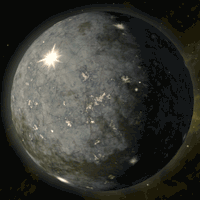Difference between revisions of "KS7"
(Completed bit of pre inserruction backstory, Infobox updated.) |
|||
| Line 4: | Line 4: | ||
|system=Gliese 884 system | |system=Gliese 884 system | ||
|body=Gliese 884 | |body=Gliese 884 | ||
| − | |position=Third | + | |position=Third planet |
|moon(s)=None | |moon(s)=None | ||
|diameter=6,779 km | |diameter=6,779 km | ||
| Line 11: | Line 11: | ||
|yearlength=365 days | |yearlength=365 days | ||
|atmosphere=O2, N2 | |atmosphere=O2, N2 | ||
| − | |temperature | + | |temperature=2°C to -15°C (35.6°F to 5°F) |
| − | + | |demonym=Colonist | |
|species=Humans | |species=Humans | ||
| − | |population=Around | + | |population=Around 2520 |
|colonized=2476 | |colonized=2476 | ||
|government=United Earth Goverment | |government=United Earth Goverment | ||
}} | }} | ||
| + | |||
| + | KS7 is a extremely cold planet settled during the Golden Age by the United Earth Government on 2475. Althought it was first thought to be unhospitable due to its extreme cold and vastness, its extensive frozen water deposits and mineral rich cave systems convinced the UEG to setup a small minning operation which would become The Colony. Eventually it would hold the KS7 UNSC Depot which would later be taken by Insurgent forces. | ||
| + | |||
| + | == History == | ||
| + | === Settlement === | ||
| + | KS7 was settled on 2475 by the UEG to serve as a mining outpost due to its rich composition of rare minerals and metals. Construction of the Upper level of the current KS7 Colony began which served as the staff living quarters and ore storage/refinement. | ||
| + | === Growth === | ||
| + | As time went on the population on KS7 grew from around 20 miners and 6 other staff to around 78 people. During this time expansion of the first level had begun to accommodate more living quarters and other areas. The growth in population and the boom in income from extreme exploitation of the planets minerals soon attracted more people into the system, including megacorporations, traders, investors, doctors, security companies, entertainers, etc. Many more minning settlements where created around the KS7 Colony, causing it to become the planetary hub. This resulted in the creation of the sublevel of the KS7 Colony, which was designed for a larger population and urban infrastructure. | ||
Revision as of 02:55, 21 January 2019
KS7 is a extremely cold planet settled during the Golden Age by the United Earth Government on 2475. Althought it was first thought to be unhospitable due to its extreme cold and vastness, its extensive frozen water deposits and mineral rich cave systems convinced the UEG to setup a small minning operation which would become The Colony. Eventually it would hold the KS7 UNSC Depot which would later be taken by Insurgent forces.
History
Settlement
KS7 was settled on 2475 by the UEG to serve as a mining outpost due to its rich composition of rare minerals and metals. Construction of the Upper level of the current KS7 Colony began which served as the staff living quarters and ore storage/refinement.
Growth
As time went on the population on KS7 grew from around 20 miners and 6 other staff to around 78 people. During this time expansion of the first level had begun to accommodate more living quarters and other areas. The growth in population and the boom in income from extreme exploitation of the planets minerals soon attracted more people into the system, including megacorporations, traders, investors, doctors, security companies, entertainers, etc. Many more minning settlements where created around the KS7 Colony, causing it to become the planetary hub. This resulted in the creation of the sublevel of the KS7 Colony, which was designed for a larger population and urban infrastructure.
